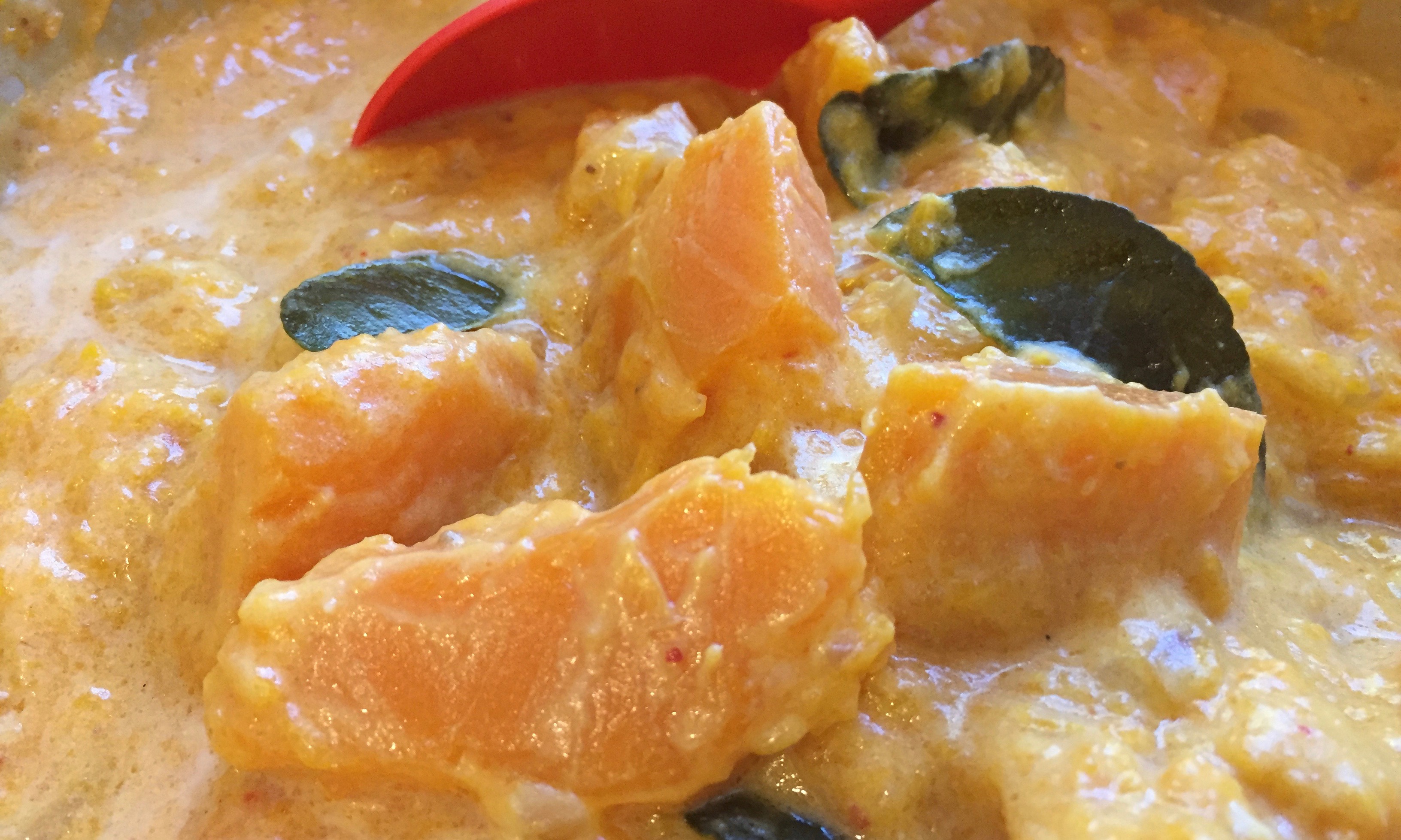What do I cook for a vegetarian? As a meat lover, this is very hard for me. I feel like I would never be able to give my vegan or vegetarian guests satiated dining.
Decades ago, I learned how to make a pumpkin curry from a Sri Lankan cook. It involved roasting a selection of spices. It was good but I never used it just because I prefer curry with meat in it.
So when I had a dinner where I needed to make some dishes vegetarian I thought I’d give pumpkin curry a try. An easier version of pumpkin curry.
Already I had planned for a Singaporean Chicken Curry, which has a very distinct taste because of the Malaysian curry powder I use. So I rather not use that curry. What else? Indian or Thai? In the end I used Thai Red Curry because I had the curry paste in my fridge.
You can use butternut squash, or conventional pumpkin but I tried kabocha, the Japanese pumpkin, which my friend Chi Wang told me she loved. This pumpkin was difficult to locate in many regular supermarkets. But I found it easily in my neighborhood Korean supermarket.
BASICS FOR THAI CURRY: My Thai friend Aw Bish taught me how to make Thai curry. Here is the basics. Put oil in a pan, add a tablespoon or two of pre-packaged Thai curry paste (red, green, yellow, Panang or Massaman) and stir periodically until it is well heated and starting to get bubbly. Then add a cup of coconut milk. Stir. When the red oil from the curry paste starts to float on the surface of the coconut milk put the ingredients in. That’s it. You can add chicken, beef, pork or vegetables. At the end of the cooking–when meat is cooked and vegetables are tender–tear kaffir leaves in pieces and throw them in the sauce. Then drizzle fish sauce which gives the curry a fuller, enhanced flavor.
I like a more robust sauce so I started this curry like how I would cook a Singapore curry by frying some onions first before adding the curry paste and coconut milk.
Cutting pumpkin: I think the hardest part of this curry is cutting that pumpkin. I cooked Pumpkin Curry with kabocha, a Japanese pumpkin, first. It tasted so good I tried the curry again a few days later with butternut squash. The latter was easier to cut but not by much. For how to cut pumpkin, click here.
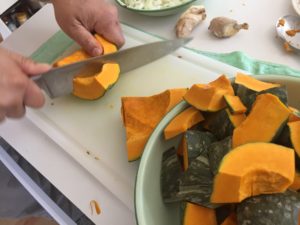
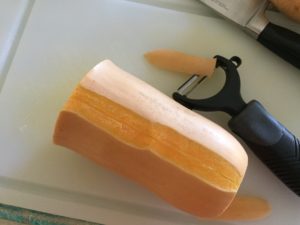
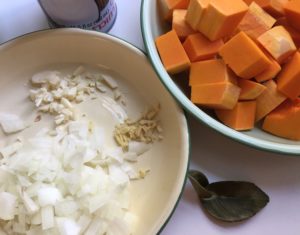
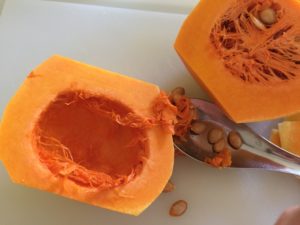
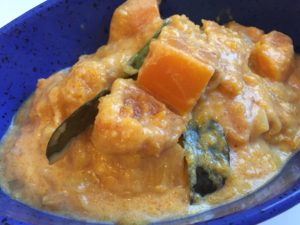
Thai Pumpkin Curry
My take: In most Thai curries, the curry paste is cooked just with coconut milk. In Singaporean curries, we fry onions, shallots, ginger and other aromatics before we add curry paste. In this recipe I fried onions until it is softened and golden before adding the curry paste.
And because I also like pieces of onion in my curry, I removed half the softened onions before adding the curry paste. The set-aside onion is returned to the pumpkin curry towards the end of cooking so they don’t overcook. If that’s too much effort, leave the onions and and let it cook with the pumpkin. OR..leave out the onions if you don’t like onions that much.
I made the curry a day ahead and it tasted better the second day!
Preparation time: 5-10 minutes
Cooking time: 30 minutes
2 tablespoons oil
1 medium sweet onion
1 tablespoon Thai red curry paste
1 cup coconut milk
1 kabocha or butternut squash, about 2 pounds
1-1½ cup water
3 pieces kaffir lime leaves, torn into pieces
2 teaspoons fish sauce (optional if cooking vegetarian. Substitute with tamari.)
Salt
In a 3-quart non-stick pan, heat 1 tablespoon oil. Add onion and fry over medium heat until onion soften. Remove half the onions. Set aside. Push rest of onion to one side.
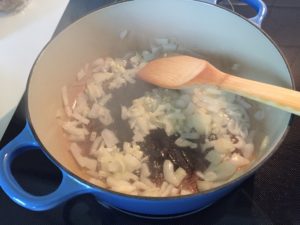

Add curry paste to the space in pan. Add remaining oil to paste. Stir and heat until paste starts to bubble.
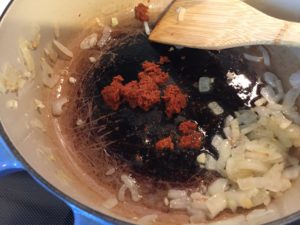
Add coconut milk and stir blending coconut milk with onion and curry paste. Heat until milk starts to boil.
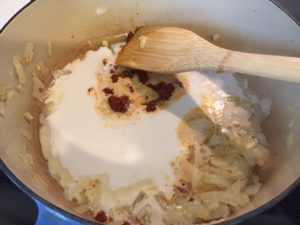
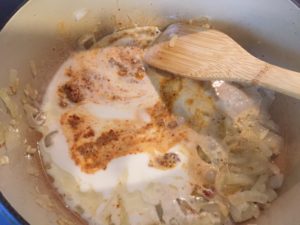
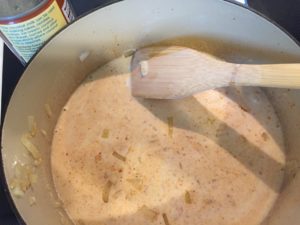
Add pumpkin and mix well. Add enough water to cover more than half the pumpkin. Bring to boil. Lower heat to simmer, mix well, and cover. Cook for about 20 minutes until pumpkin starts to become tender.
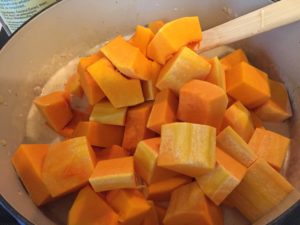
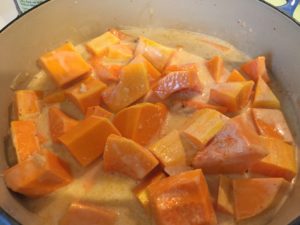
Return onions to pot. Add kaffir leaves and fish sauce. Add salt to taste. Simmer for another 5 minutes until pumpkin is perfectly tender. Turn off heat.
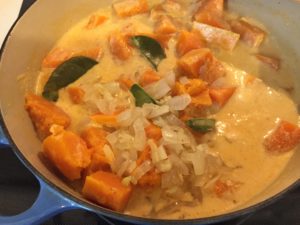
Pumpkin can be served at room temperature.
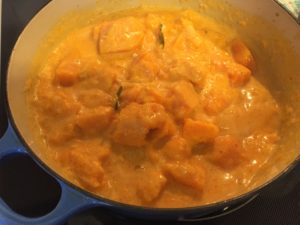
NOTES
Caution about using Thai Curry Paste:
This chili paste is spicy. More is not necessarily tastier. You don’t want to ruin your curry because it is too spicy. I used only one spoonful in my recipe above because I wasn’t planning to have a super spicy curry.
Add one tablespoon to start and taste the curry after adding the coconut milk. If you prefer it to be hotter, add a little (half spoonfuls) more at a time. You can add more curry paste after cooking the coconut milk. Just blend the paste in with the liquid.
Most packaged Thai curry pastes–red, green, or yellow–are equally spicy. Proceed with caution. You have been warned. For more on Thai Red Curry Paste, click here.
On how to use kaffir leaves, click here.
Variation
Different flavor: Squeeze lime juice to the curry just before serving.
Other vegetables: Add snow peas, or canned baby corn to curry.
After cooking pumpkin for 20 minutes, add another half cup of water to curry, bring to boil and add a handful of snow peas and half a can of baby corn. Bring to boil and simmer for another 5-10 minutes. Adjust taste with salt.
